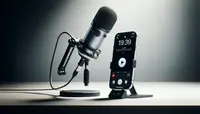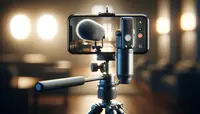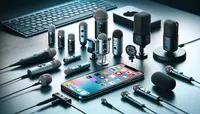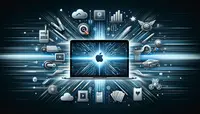Maximizing iPhone Audio Quality for Professional Podcasting
Maximizing iPhone audio quality for professional podcasting is like turning your everyday smartphone into a high-end recording studio. It's all about knowing the right tricks to make your iPhone's audio go from good to great. So, let's dive in!
Use an External Microphone
First things first, your iPhone is already a powerhouse of technology. It's got a decent microphone built in, but for professional podcasting, we need to step it up a notch.
The secret sauce to boosting your iPhone's audio quality lies in external microphones. These mics are designed to capture sound more clearly and reduce background noise. You can find mics that plug directly into your iPhone's lightning port or connect wirelessly.
I reviewed the best external microphones you can find for your iPhone in this article.
Find the best environment
Once you've got your external mic, the next step is to find the perfect recording environment. This doesn't mean you need to rent out a professional studio. Instead, look for a quiet, indoor space with minimal echo. Soft furnishings like carpets, curtains, and sofas can help absorb sound and reduce echo. Even recording in a closet full of clothes can work wonders!
Choose the correct application
Now, let's talk about recording apps. While your iPhone's built-in Voice Memos app can do the job, there are specialized apps that offer more control over your recording. Apps like Ferrite Recording Studio or GarageBand for iOS come with a bunch of features to tweak your audio. You can adjust levels, cut out mistakes, and even add some basic effects to enhance your voice.
Learn how to edit your podcast
Speaking of tweaking audio, let's touch on editing. Editing your podcast is crucial for achieving that professional sound. You might want to remove awkward pauses, reduce background noise, or balance different speakers' volumes. While you can do some basic editing on your iPhone, using a computer with software like Audacity (which is free!) or Adobe Audition can give you more precision.
It's also important to be mindful of your recording technique. Keep a consistent distance from your microphone to avoid volume fluctuations. Also, watch out for 'plosive' sounds - those pesky 'p' and 'b' sounds that can cause a burst of air and distort your audio. A simple trick is to speak slightly off to the side of the mic rather than directly into it.
Audio formats and quality
Now, let's talk about file formats and quality. When you're done recording and editing, you'll want to save your podcast in a format that retains its quality but isn't too large. The AAC format is a great choice for iPhones as it offers high quality at a relatively small file size. Remember, a smaller file size makes it easier for your listeners to download and stream your podcast.
Promoting your podcast
Lastly, let's not forget about promotion. A podcast is only as good as its audience. Share your podcast on social media, collaborate with other podcasters, and engage with your listeners. Getting feedback and building a community around your podcast can also provide insights into how to improve your content and audio quality.
Conclusion
In conclusion, turning your iPhone into a podcasting powerhouse is all about the right tools, techniques, and a bit of creativity. With an external microphone, a quiet recording space, a good recording app, some editing magic, and the right approach to recording, you can produce professional-quality audio right from your smartphone. Remember, it's not just about the gear; it's about how you use it. Happy podcasting!










Post your comment